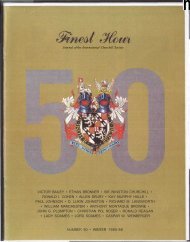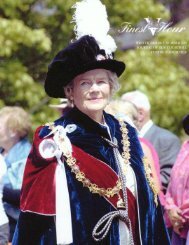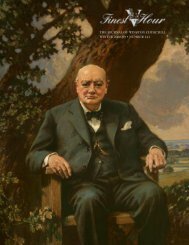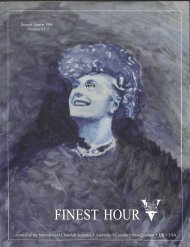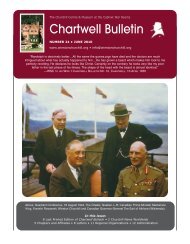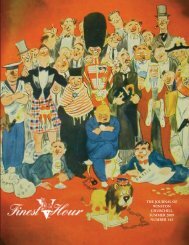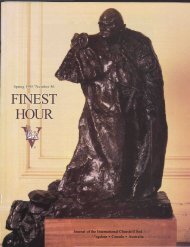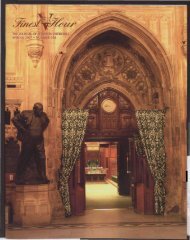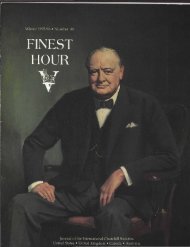You also want an ePaper? Increase the reach of your titles
YUMPU automatically turns print PDFs into web optimized ePapers that Google loves.
and the movement of armoured cars was restricted. Afterall, even the best of them were no more than conventionalcars with about four tons of armour bolted on,even if many were Rolls-Royces. Most were handed overto the Army while the men dispersed. Some went backto sea. The Duke took his armoured cars to Egypt butothers, fired up with the potential of armoured warfareon land, returned to London and thought up new ideas.Among them was a chap named TomHetherington, who somehow managed to retain commissionsin the Army and the Navy at the same time.He dreamed up the idea of a huge machine, somethingone might associate with H. G. Wells, which would rollinto Germany on 40-foot-diameter wheels, wade acrossthe Rhine and bring the war to an end in weeks.Hetherington and <strong>Churchill</strong> came together at adinner, hosted by Westminster, and there is little doubtthat the young officer’s impossible design reignited theFirst Lord’s interest. <strong>Churchill</strong> himself was, above all, arealist, who dealt best with what he could see and understand.Commodore Murray Sueter, Director of the AirDepartment at the Admiralty, remembers <strong>Churchill</strong>storming around his office saying, “We must crush thetrenches, D.A.D.: It is the only way; it must be done.” 1<strong>Churchill</strong>’s first effort along these lines wasabortive. Two municipal steam rollers were acquired,linked up side by side and then driven like mad at atrench parapet, only to get stuck in the soft mud and sitthere, belching smoke, rollers spinning, going nowhere.On a more practical level the First Lord ordainedan Admiralty Landships Committee, 2 which met (forthe first time in the First Lord’s rooms at the Admiraltysince he had the flu) under the chairmanship of EustaceTennyson D’Eyncourt, Director of Naval Construction,in February 1915. This committee, and the driving forcebehind it, was <strong>Churchill</strong>’s greatest contribution to theevolution of the tank.The Landships Committee’s first problem was todecide upon the respective merits of wheels orCaterpillar tracks. Hetherington’s huge wheeled designwas simply too big, and even a half-scale version,designed by William Foster and Company in Lincoln,was rejected at an early stage. That left tracks. Buttracks, as a means of crossing rough ground, were hardlyknown in Britain and early prototypes mostly had to beimported from the USA. Murray Sueter educated<strong>Churchill</strong> on the properties of tracks by inviting himdown to Horse Guards to push a small tracked truckaround. Soon the Landships Committee had experimentsgoing on everywhere and <strong>Churchill</strong> attended onewith Lloyd George, as the following article notes, at atesting ground near Wormwood Scrubs.Even so, <strong>Churchill</strong> was better with men thanmachines. and his last great contribution to this saga wasto appoint a pushy young merchant banker, one AlbertStern, as secretary to D’Eyncourt’s Committee.Commissioned as a Lieutenant in the RNAS, Stern wentat it like mad, with no respect for rank or station. Sterndidn’t tread on toes—he leapt on them, and managed tomake himself very unpopular. But he got things done. Aprototype machine, first known as “Little Willie,” wasrunning by the summer of 1915. Its successor—“BigWillie” or “Mother”—the true prototype of all BritishWorld War I tanks—was completed the followingDecember and a matter of months later, productionbegan. As Marcus Frost relates next, tanks went intoaction for the first time on 15 September 1916. In thecircumstances, it was an amazing feat to imagine, invent,design and produce a brand new weapons system in soshort a time.<strong>Churchill</strong>, by then, was out of the picture.Reaction to the Dardanelles reverse, his resignation fromthe government and subsequent return to uniform, kepthim away from developments in Britain. Yet it did notleave his mind, and from the trenches he sent Sir JohnFrench a document entitled “Variants of the Offensive,” 3which proved to be very influential. It was not simply aplea for the tank, but a broad-based look at the prob- >>ORIGINS: Tommy Hetherington, above, drives the Killen-Straittractor through barbed wire entanglements at WormwoodScrubs. Albert Stern strides at left; Lloyd George and <strong>Churchill</strong>,though present, are not in the photo. A Pedrail one-ton truck,below, of the type <strong>Churchill</strong> pushed around on Horse GuardsParade as an example of a track-laying vehicle.FINEST HOUR 135 / 43



